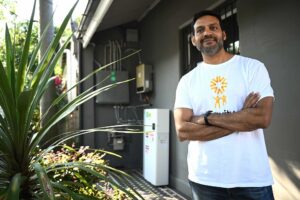Queensland based transmission company Powerlink says it will deploy battery storage to help solve grid stability problems such as system strength as part of a new multi-faceted approach to handling the surge in wind and solar generation.
Battery storage has suddenly emerged as a solution to grid issues that many engineers thought could only be solved by synchronous generation or spinning machines, and the newly affirmed capabilities of battery inverters is good news for the inevitable switch to a grid dominated by wind and solar.
Earlier this week, as RenewEconomy reported exclusively, the Australian Energy Market Operator confirmed that re-tuning of inverters at four solar farms and a wind farm had effectively solved “system strength” issues in north Queensland, meaning machines such as synchronous condensers would not be needed.
See: Groundbreaking solar inverter solution points way to grid free of fossil fuels
Powerlink CEO Paul Simshauser says that a series of studies and reports done with the Australian Renewable Energy Agency, zinc producer and solar farm operator Sun Metals, renewables company Pacific Hydro and GHD, confirmed the key role that battery storage could play.
“The final report demonstrated the role grid forming batteries can play in enabling renewables and supporting the safe and stable operation of the power system,” Simshauser said in a statement.
“We’ve found grid forming batteries can supply system strength, as well as other key services which support the network and assist renewable connections to effectively operate.
“Powerlink will now apply these learnings to reduce the time, cost and risk of renewable connections to the grid, benefiting both Powerlink and customers in the long-term.
“With the recent influx of battery interest by generators and developers in Queensland, we now have a number of opportunities to pilot grid forming batteries and validate our report findings through field studies.”
Grid forming batteries create their own frequency and voltage wave forms, which means that rather than following the signals of other installations, they can “hold their own” and maintain stability in the event of a major grid disruption.
They are often used in small off-grid systems, but are now increasingly deployed in larger networks – such as those that power the huge mines in the Pilbara – and are being increasingly deployed in the main grid, including at the Hornsdale Power Reserve, which showed its capabilities after the recent Callide coal explosion.
Battery storage will not be the only technology solution considered by Powerlink to solve system strength, and it also looking at using synchronous condensers, but only where they are centrally located and can provide services for multiple customers.
This is yet another repudiation of the ad hoc, chaotic, expensive and ultimately self defeating “do no harm” rule introduced by regulators several years ago, against the advice of many experts.
That “do no harm” requirement did the opposite of what was intended. It added tens of millions of dollars to the cost of some wind and solar projects, and ultimately served to weaken rather than strengthen the grid, according to transmission companies such as Transgrid.
Simshauser said one of the key findings of its studies confirmed that a centralised synchronous condenser solution could provide significant network and financial benefit when compared to renewable proponents having to provide their own.
Powerlink is looking to provide that capability as a service, presumably at a cost, to new wind and solar projects.
“System strength is a complex issue, with the study highlighting there is no one ‘best’ form of system strength remediation that can be applied to all renewable projects,” Simshauser said in a statement.
“The reports demonstrate the merits of each different approach, but really confirmed that solutions have to be tailored for renewable proponents by thoroughly reviewing the particular circumstances of the network connection.
“Our key goal is delivering a safe, reliable and secure transmission network for Queensland and facilitating the transition to a low carbon future. This study has been another step in the right direction to achieve this.”
Battery storage, however, is proving itself capable of providing system services at multiple levels. The six operating batteries in the main grid have successfully captured most of the frequency control market, and a new market – fast frequency control – is being created in recognition of their speed and flexibility.
Batteries such as Hornsdale are now delivering “synthetic inertia” and operate as “virtual synchronous machines”, which is the next step up from grid forming inverters, using software to allow the grid forming inverters to co-operate and act as a shock absorber for grid disturbances.
Batteries are also being deployed as “virtual transmission” lines, serving to increase the capacity of existing power lines to absorb heavier loads and more renewables.
The Victoria big battery – which at 300MW/540MWh will be the biggest in the country, and will boost the capacity of the NSW-Victoria transmission link at peak times. It is being built by Neoen using Tesla megapack technology.
Victoria’s Powercor is also proposing up to 20 big batteries scattered around its network to support the increase of wind and solar and boost grid security, while networks such as Western Power in WA and Ausgrid in NSW and United Energy in Victoria are using smaller “community” scale batteries to support rooftop solar in their networks.
Queensland currently does not have any big batteries of note in its grid, although the first, a 100MW/150MWh installation at Wandoan South, is being built in southern Queensland.
Many more are proposed or in the pipeline, including next to some of the state’s biggest coal generators, some announced in a “battery blitz” that followed the Callide incident.
For more of current and future battery storage projects, please go to RenewEconomy’s new battery storage map: Big Battery Storage Map of Australia








